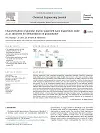Different magnesium (Mg) containing nanoparticles, magnesium hydroxide, (Mg(OH)2), magnesium oxide (NMgO) and activated magnesium oxide (AcMgO) were tested, in a first step, to identify a highly efficient adsorbent for groundwater (GW) defluoridation. Consequently, the NMgO, which was the most suitable material, was impregnated on a granular matrix (sand) to produce a reactive filtration material (GSN). Amongst the different features (surface area, total pore volume, pHpzc mineralogical assemblage and particle size) of the investigated magnesia species, only the particle size had profound influence on defluoridation efficiency. Kinetic analysis showed that the defluoridation process was limited by pore diffusion while experimental evidences showed that both specific and non-specific mode of interaction were the underlying mechanism of the process. In the defluoridation system, the thermodynamic parameters (ΔG) of precipitation of magnesium fluoride (MgF2) was negative but no MgF2 peak was observed in the XRD pattern of the spent GSN. The defluoridation efficiency of the GSN in a real groundwater system at different initial F− concentrations was comparable with that of simulated water. The evaluation of the quality characteristics of the treated water showed that Mg2+ that leached from the GSN enhanced the total hardness while the concentrations of Ca2+ was greatly reduced. Reduction in the magnitude of the total inorganic carbon content of the GW was observed.
